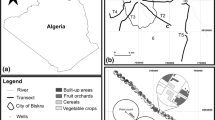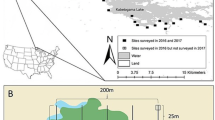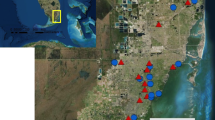Abstract
Urbanization and other land cover changes have been particularly detrimental to wetlands throughout the planet. One wetland specialist that may be sensitive to land cover changes surrounding wetlands is the round-tailed muskrat (Neofiber alleni; hereafter RTM). The RTM is a wetland obligate rodent that appears to have declined over the last half century and is a species of concern in Florida, where it is a near endemic. To determine if urbanization or other land cover influenced the distribution of RTMs we took a multi-scaled approach to examine the occurrence of RTMs and their associated vegetation in North-Central Florida. We detected RTMs on 19 of 72 sample plots and used a Classification And Regression Tree (CART) to determine that dogfennel (Eupatorium capillifolium) was negatively associated with RTMs and maidencane (Panicum hemitomon) was positively associated with their occurrence on sampling plots. Examining the influence of landscape composition for 2 km surrounding our plots we found that RTM occurrence was negatively related to urban land cover. Further, we found that dogfennel increased and maidencane decreased as urbanization increased in the surrounding landscape. Our research suggests that conservation of RTMs and their associated vegetation should focus on limiting urban sprawl at least within 2 km of wetlands.





Similar content being viewed by others
References
Bergstrom BJ, Farley T, Hill HL, Hon T (2000) Ecology and conservation of a frontier population of the round-tailed muskrat (Neofiber alleni). Fourth colloquium on conservation of mammals in the Southeastern United States. Occasional papers for the North Carolina museum of natural sciences and the North Carolina biological survey 12:74–82
Birkenholz D (1963) A study of the life history and ecology of the round-tailed muskrat (Neofiber alleni true) in north-Central Florida. Ecol Monogr 33:255–280
Booth DB (1991) Urbanization and the natural drainage system – impacts, solutions and prognoses. Northwest Environ J 7:93–118
Booth DB, Hartley D, Jackson R (2002) Forest cover, impervious-surface area, and the mitigation of stormwater impacts. J Am Water Resour Assoc 3:835–845
Breiman L, Friedman JH, Olshen RA, Stone CG (1984) Classification and regression trees. Wadsworth International Group, Belmont
Brown LN (1997) Mammals of Florida. Windward Publishing Inc, Miami
Brown DJ (2007) Using a global VNIR soil-spectral library for local soil characterization and landscape modeling in a 2nd order Uganda watershed. Geoderma 140:444–453
Burman P (1989) A comparative study of ordinary cross-validation, v-fold cross validation, and the repeated learning-testing methods. Biometrika 76:503–514
Burnham KP, Anderson DR (2002) Model selection and multimodel inference: a practical information-theoretic approach, 2nd edn. Springer-Verlag, New York
Dahl TE (1990) Wetlands losses in the United States 1780s to 1980s. US. Department of the Interior, Fish and Wildlife Service, Washington DC
Dahl TE (2000) Status and trends of wetlands in the conterminous United States 1986 to 1997. U.S. Department or the Interior, Fish and Wildlife Service, Washington DC
Dahl TE (2005) Florida’s wetlands: an update on status and trends 1985 to 1996. U.S. Department of the Interior, Fish and Wildlife Service, Washington DC
Dahl TE (2011) Status and trends of wetlands in the conterminous United States 2004 to 2009. U.S. Department of the Interior, Fish and Wildlife Service, Washington DC
Daubenmire RF (1959) A canopy-coverage method of vegetational analysis. Northwest Sci 33:43–64
David PG (1996) Changes in plant communities relative to hydrologic conditions in the Florida Everglades. Wetlands 16:15–23
Davidson NC (2014) How much wetland has the world lost? Long-term and recent trends in global wetland area. Mar Freshw Res 65:934–941
De’ath G, Fabricius KE (2000) Classification and regression trees: a powerful yet simple technique for ecological data analysis. Ecology 81:3178–3192
Fan J, Upadhye S, Worster A (2006) Understanding receiver operating characteristic (ROC) curves. Can J Emerg Med 8:19–20
Fawcett T (2005) An introduction to ROC analysis. Pattern Recogn Lett 27:861–874
Florida Natural Areas Inventory (2012). Florida landcover classification system definitions for the cooperative landcover map v2.3. Fish and wildlife research institute, Florida fish and wildlife conservation commission. http://www.fnai.org/PDF/Cooperative%20Land%20Cover%20v2.3%20Definitions.pdf. Accessed 4 Jul 2014
Gibbs JP (1993) Importance of small wetlands for the persistence of local populations of wetlandassociated animals. Wetlands 13(1):25-31
Havens KE, Gawlik DE (2005) Lake Okeechobee conceptual ecological model. Wetlands 25:908–925
Hines JE (2006) PRESENCE2 - Software to estimate patch occupancy and related parameters. USGS-PWRC. http://www.mbr-pwrc.gov/software/presence.htm. Accessed 15 Oct 2013
Houlahan JE, Makkay KK, Findlay CS (2003) The effects of adjacent land use on wetland amphibian species richness and community composition. Can J Fish Aquat Sci 60:1078–1094
Humphrey SR (1992) Rare and endangered biota of Florida. Vol. 1: mammals. University Press of Florida, Gainesville
Jakubauskas M, Kindscher K, Fraser A, Debinski D, Price KP (2000) Close-range remote sensing of aquatic macrophyte vegetation cover. Int J Remote Sens 21:3533–3538
Johnson KG, Allen MS, Havens KE (2007) A review of littoral vegetation, fisheries, and wildlife responses to hydrologic variation at Lake Okeechobee. Wetlands 27:110–126
Lefebvre LW, Tilmant JT (1992) Round-tailed muskrat Neofiber alleni. In: Humphrey SR (ed) Rare and endangered biota of Florida. Volume I. Mammals. University Press of Florida, Gainesville
MacKenzie DI, Bailey LL (2004) Assessing the fit of site-occupancy models. J Agric Biol Environ Stat 9:300–318
MacKenzie DI, Nichols JD, Andrew RJ, Pollock KH, Bailey LL, Hines JE (2006) Occupancy estimation and modeling. Academic Press, London
McCune B, Grace JB, Urban DL (2002) Analysis of ecological communities. MjM Software Design, Gleneden Beach
Orange Creek Basin Working Group and Florida Department of Environmental Protection (2007) Orange creek basin management action plan. Florida Fish and Wildlife Conservation Commission, Tallahassee
Pearse AT, Kaminski RM, Reinecke KJ, Dinsmore SJ (2012) Local and landscape associations between wintering dabbling ducks and wetland complexes in Mississippi. Wetlands 32:859–869
Reinelt L, Horner R, Azous AL (1998) Impacts of urbanization on palustrine (depressional freshwater) wetlands – research and management in the Puget sound region. Urban Ecos 2:219–236
Richter KO, Azous AL (1995) Amphibian occurrence and wetland characteristics in the Puget sound basin. Wetlands 15:305–312
Schooley RL, Branch LC (2005) Survey techniques for determining occupancy of isolated wetlands by round-tailed muskrats. Southeast Nat 4:745–756
Schooley RL, Branch LC (2006) Space use by round-tailed muskrats in isolated wetlands. J Mammal 87:495–500
Schooley RL, Branch LC (2011) Habitat quality of source patches and connectivity in fragmented landscapes. Biodivers Conserv 20:1611–1623
Simon JA, Snodgrass JW, Casey RE, Sparling DW (2009) Spatial correlates of amphibian use of constructed wetlands in an urban landscape. Landsc Ecol 24:361–373
Smith SK, Rayer S (2012) Projections of Florida population by county 2011–2040. Bureau of Economic and Business Research. University of Florida Bulletin 162 (revised). <http://www.youredc.com/wp-content/uploads/2012/09/Population-projections-FPS-162-Revised.pdf>. Accessed 4 Jul 2014
Southeast Regional Climate Center (2013) Gainesville municipal airport monthly climate summary. <http://www.sercc.com/cgi-bin/sercc/cliMAIN.pl?fl3326>. Accessed 20 Apr 2013
St Johns River Water Management District (2015) Orange Creek Basin. <http://floridaswater.com/orangecreek/>. Accessed 6 Dec 2015
United States Department of Agriculture (2016) Plant Fact Sheet. Maindencane Panicum hemitomon Schult. United States Department of Agriculture, Natural Resources Conservation Service. http://www.nrcs.usda.gov/Internet/FSE_PLANTMATERIALS/publications/etpmcfs8045.pdf Accessed 29 Aug 2016
Van Deelen TR (1991) Eupatorium capillifolium. In: Fire Effects Information System, [Online]. U.S. Department of Agriculture, Forest Service, Rocky Mountain Research Station, Fire Sciences Laboratory. http://www.fs.fed.us/database/feis/plants/forb/eupcap/all.html. Accessed 30 May 2014
Willis JM, Hester MW (2004) Interactive effects of salinity, flooding, and soil type on Panicum hemitomon. Wetlands 24:43–50
Wunderlin RP, Hansen BF (2003) Guide to the vascular plants of Florida, 2nd edn. University Press of Florida, Gainesville
Zedler JB, Kercher S (2005) Wetland resources: status, trends, ecosystem services, and restorability. Annu Rev Environ Resour 30:39–74
Zwick PD, Carr MH (2006). Florida 2060: a population distribution scenario for the state of Florida. http://www.1000friendsofflorida.org/connecting-people/florida2060/. Accessed 29 Aug 2016
Acknowledgements
We thank Terry Doonan and Clinton Smith of the Florida Fish and Wildlife Conservation Commission for initiating and supporting this project. We acknowledge Kelly McPherson of the Alachua County Environmental Protection Department and Alachua County Forever, Andrea Christman of the Florida Department of Environmental Protection, Michael Stallings of the Putnam Land Conservancy and Benjamin Dow of Plum Creek Timber for facilitating site access and project logistics. We acknowledge Christa Zweig of the South Florida Water Management District, Matthew Burgess of the University of Florida for their analytical and technical guidance. Finally we thanks all of the student volunteers from the University of Florida without whom this work would not have been possible. This research was funded by the Florida Fish and Wildlife Conservation Commission.
Author information
Authors and Affiliations
Corresponding author
Electronic supplementary material
Online Resource 1
(DOCX 16 kb)
Rights and permissions
About this article
Cite this article
Faller, C.R., McCleery, R.A. Urban land cover decreases the occurrence of a wetland endemic mammal and its associated vegetation. Urban Ecosyst 20, 573–580 (2017). https://doi.org/10.1007/s11252-016-0626-1
Published:
Issue Date:
DOI: https://doi.org/10.1007/s11252-016-0626-1




